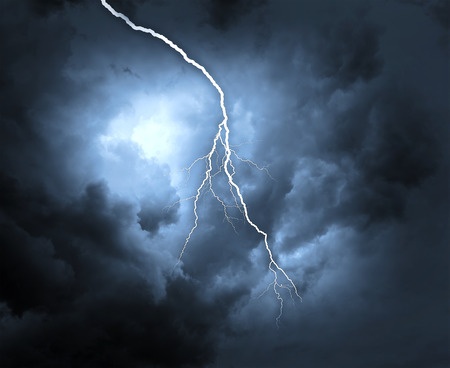What Public Warning Systems Protect You During Thunderstorms?
July 6, 2015 | Category: Defective Products, Wrongful Death | Share The phrase "Lightning Capital" is often used to describe Florida because Florida has more thunderstorms and lightning strikes each year than anywhere else in the United States. With having more lightning strikes, comes more deaths and injuries from lightning. According to statistics, Florida averages more than 30 injuries and 10 deaths from lightning each year. Fifty percent of deaths and injuries occur to those involved in recreational activities. The National Oceanic and Atmospheric Administration (NOAA) says that between 1959 and 2012, lightning strikes killed 498 people in Florida. Roughly one in 10 people who are struck die. Those who are struck by lightning but survive can suffer short- and long-term effects to their nervous systems and bodies. These effects include headaches and soreness to irritability and trouble with concentration. NOAA reports that three quarters of fatalities from lightning strikes occurred between June and August with most of them occurring in July.
The phrase "Lightning Capital" is often used to describe Florida because Florida has more thunderstorms and lightning strikes each year than anywhere else in the United States. With having more lightning strikes, comes more deaths and injuries from lightning. According to statistics, Florida averages more than 30 injuries and 10 deaths from lightning each year. Fifty percent of deaths and injuries occur to those involved in recreational activities. The National Oceanic and Atmospheric Administration (NOAA) says that between 1959 and 2012, lightning strikes killed 498 people in Florida. Roughly one in 10 people who are struck die. Those who are struck by lightning but survive can suffer short- and long-term effects to their nervous systems and bodies. These effects include headaches and soreness to irritability and trouble with concentration. NOAA reports that three quarters of fatalities from lightning strikes occurred between June and August with most of them occurring in July.
Last summer, on July 22, 2014 a lightning strike at Fort Myers Beach left one person dead and two injured during a heavy rainstorm in the afternoon, according to an NBC-2 news report.
As we are now in the rainy season, every storm brings the potential for lightning. It is still impossible to predict the exact location of where lightning will strike. However, there are products and systems which have been designed to protect and alert people as the probability of a lightning strike increases.
Lightning protection products protect when lightning strikes. Lightning warning systems protect by alerting individuals of the potential of lightning strikes.
Florida Weekly reported that the early warning systems generally have a 15-second horn blast that warns of a lightning threat. This warning blast often occurs minutes before the sky even turns dark. There are then three shorter 5-second blasts that signal "all clear" well after the weather clears. Most people, according to the article, are killed or injured by lightning - not during, but just before or after a storm, many times when the sky is still sunny and blue.
Lightning alert systems have been installed in many public areas of Lee, Collier, and Charlotte counties.
Lee County
In January 2013, Lee County installed the Weather-Bug lightening alert system in all schools at a system at a startup cost of $182,500 for the 13 public high schools with a budgeted $13,000 for annual service maintenance according to NBC-2. Lee commissioners later approved the $132,644 to install the WeatherBug system in the summer of 2013 at parks, a cost that was offset by using the high school’s existing detection equipment. The Lee County Parks and Recreation Weather-Bug system sounds an uninterrupted 15-second siren and a strobe light activates when in-cloud and cloud-to-ground lightning is detected up to 10 miles away. People who hear the horn and/or see the light need to seek shelter immediately. When the system no longer detects a threat, three 5-second blasts from the horn will sound and the strobe light will stop working. This is the signal that it is safe to return outdoors.
Charlotte County
Charlotte County Public School system installed the same type of lightening alert system as Lee County in late 2013.
Collier County
The Collier County School District and the county’s park system installed Thor Guard, a competing brand to the WeatherBug system, which detects atmospheric conditions conducive to lightning.
"Lightning strikes are dangerous. It is never safe to be outside during a thunderstorm. The early warning systems can help warn people about the potential of lightning strikes and need to be heeded even when the sky look blue," says Fort Myers Accident Attorney, Randall Spivey of Spivey Law Firm, Personal Injury Attorneys, P.A.
The State Building Code in Florida requires that all health care facilities, which includes outpatients buildings and extended care homes, as well as schools and correctional facilities have lightning protection. Lightning protection products intercept lightning strikes and carry them to the ground by placing rods at regular intervals on all the highest and most exposed parts of a structure.
If you or a loved one has been injured as the result of a lightning strike at any of the facilities covered by Florida law, contact Spivey Law Firm, Personal Injury Attorneys, P.A. for a free consultation.
Fort Myers Accident Attorney, Randall L. Spivey is a Board Certified Trial Attorney – the highest recognition for competence bestowed by the Florida Bar and a distinction earned by just one (1%) percent of Florida attorneys. He has handled over 2,000 personal injury and wrongful death cases throughout Florida. For a free and confidential consultation to discuss your legal rights, contact the Spivey Law Firm, Personal Injury Attorneys, P.A., in Lee County at 239.337.7483 or toll free at 1.888.477.4839,or by email to Randall@SpiveyLaw.com. Visit SpiveyLaw.com for more information. You can contact Spivey Law Firm, Personal Injury Attorneys, P.A.in Charlotte County at 941.764.7748 and in Collier County 239.793.7748.

